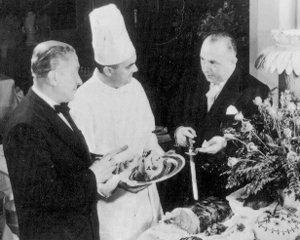French cooking methods and traditions have a strong presence in US eating culture. The very words Americans use to describe most eateries are borrowed right out of the French language. “Restaurant,” “Café,” and “Bistro” are all terms borrowed from the French language to describe an eating experience.
Early Restaurants in the US
While American Colonial period inns typically offered some sort of food and drink, they did not generally offer a selection of choices and none had a menu. The first precursors to modern restaurants were brought to the U.S. by French immigrants, shortly after the American Revolution. They had already seen restaurants’ popularity and revenue potential blossom in their home country. After the French revolution, cooks who had been under the aristocracy started opening up their own establishments, catering to the new French middle class.
The first documented successful French-style restaurant in the US opened shortly after the French helped the American colonies win their independence from Britain. It was opened in Boston in 1794 by Jean Baptiste Gilbert Playpat, former cook to the Archbishop of Bordeaux. The French restaurants of the time specialized in “restorative” soups and stews, and Julien’s Restorator was no different. The roots of the modern restaurant business model can be seen in his menu of different soups, all with set prices aimed at middle class buyers with a taste for epicurean food.
The 1939 World’s Fair
The next giant leap forward for the French restaurant industry in the U.S. happens at the 1939 New York World’s Fair. “Le Restaurant du Pavilion de France,” establishes what modern diners in the U.S. and worldwide have come to expect from a fine French restaurant dining experience right down to chefs donning traditional chef coats.

The restaurant project for the fair was headed by Jean Drouant and Louis Barraya who between them owned or managed seven restaurants in the Paris area. They brought with them 98 of the best cooks, waiters, m’aitres d’hotel, and wine stewards recruited from their own establishments and restaurants across from France. No attempt was made to change the dishes’ names or ingredients to appear more familiar to the American palate of the time. Their goal was to recreate the best dining experience that was available in Paris’ most elite restaurants. According to William Grime’s Appetite City:
“Once visitors to the fair entered the French Pavilion, they were in France. And when in France, they ate as the French did, on dishes like leg of lamb boulangère, coq au vin, suprême de barbue Mornay, and crêpes suzettes.”
Under the watchful eye of Maitre d’ Henri Soulé, the restaurant introduced diners to table-side service, desserts flambé, and all the pageantry and beauty of the Paris dining scene.
The restaurant was full with lines into the street every night it was open in 1939, and arguably the most successful restaurant on the grounds. As well as introducing the public to “haute cuisine,” it is also credited with introducing the current system of chefs and divisions of kitchen duties between individuals still in use in professional kitchens today.
The World’s Fair continued the summer of 1940, but World War had started and attendance to the fair fell off sharply. France was already fighting with Germany. Maitre d’ Henri Soulé had already joined the French Army, but decided to come back to America when he found out the government had decided to open the restaurant after all, with a much reduced staff from the previous year.
Two weeks after the restaurant re-opened, Germany invaded France, and the Frenchmen in America carried with their mission to introduce French culture and cuisine to fair goers amid the horrible reports of the war back home.
When the World’s Fair closes for good in the Fall of 1940, Henri Soulé and 9 other staff have no home to return to. They open “le Pavilion” Restaurant in New York ushering in the modern age of haute cuisine in the USA.
